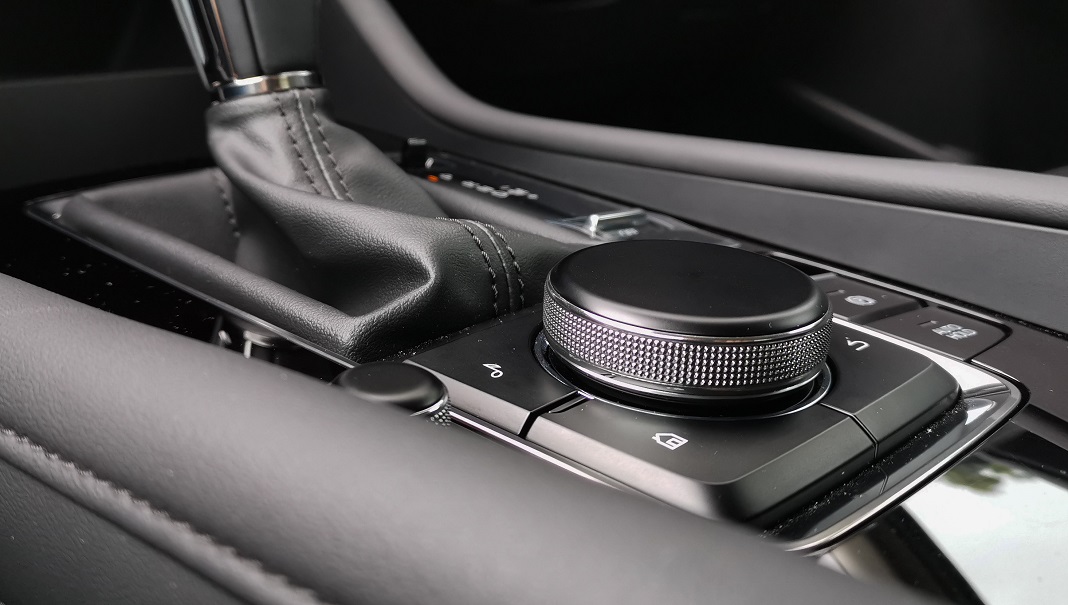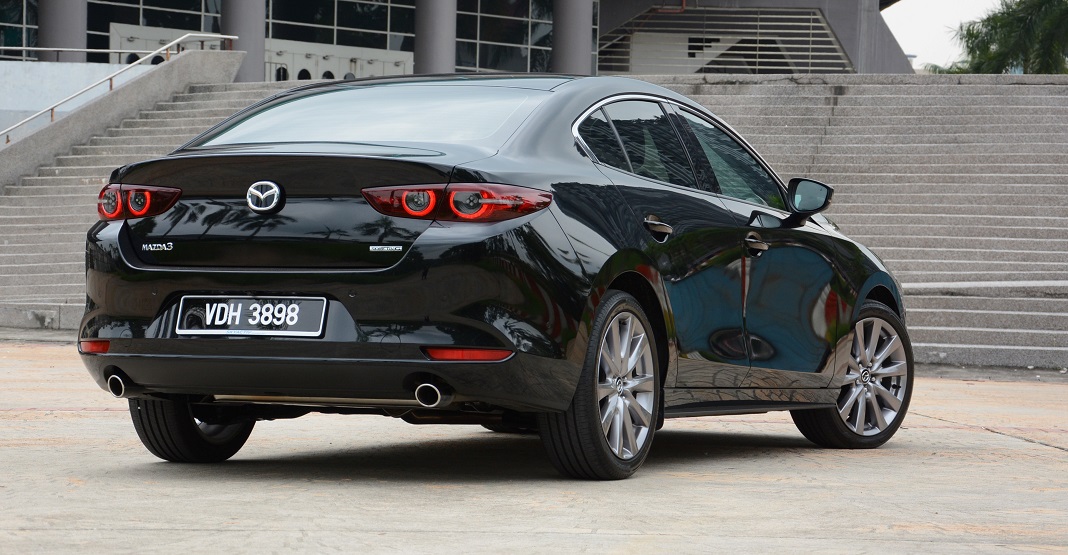 With beauty comes great expectations, so much so that when handed the keys to the four-door Mazda 3 saloon instead of the gorgeous hatchback, I felt a tad deflated. At least it’s the 2.0-litre High Plus variant that comes with nice 18-inch alloys, swivelling LED headlamps and active safety extras (including Mazda’s Radar Cruise Control).
With beauty comes great expectations, so much so that when handed the keys to the four-door Mazda 3 saloon instead of the gorgeous hatchback, I felt a tad deflated. At least it’s the 2.0-litre High Plus variant that comes with nice 18-inch alloys, swivelling LED headlamps and active safety extras (including Mazda’s Radar Cruise Control).

Mazda don’t do ‘boring’, they never did. But in the last decade or so, they’ve been stringing together some sharp designs to go with driver-focused abilities, so the buzz that surrounds every new model isn’t without reason. It’s no different with the new 3, both body-styles turn heads, the hatchback more so than the saloon.

Despite the test unit’s muted black paint job, the 3 sedan still cuts a dashing figure with its RWD-like proportions (comparatively long hood next to other FWDs), tidy overhangs and wind-cheating roofline. The way which the C-pillar window kink tucks back onto the shoulder line also harks of the second-generation Lexus IS. The choice of going with the chrome surround on its bold and enlarged grille fits with the more grounded status of a four-door saloon, judging from the admiring glances from other motorists, I’d say they done a good job.

It’s all in the execution
Have you ever sat behind the steering wheel of a new car for the first time and found everything to feel ‘just right’? The Mazda 3 interior is executed near flawlessly, for most parts anyway. The driving position is perfect, the tactility of the switchgear and the choice of materials radiate premium-ness, and it’s visually stylish and upmarket too.

With manufacturers turning to virtual controls to replace physical ones (just too much technology to pack), it’s reassuring to know that a sensible mix of digital and analogue interfaces is still the way forward, at least until cars can read minds. Just look at the 3’s air-con controls; not only are they intuitive to use, those knurled rotary knobs also add to the aesthetic value of the dashboard.

Perhaps the biggest surprise is the MZD Connect system. Mazda has given its iDrive-aping interface a much-needed overhaul, but with restraint and in good taste, prioritising legibility and ease of use over fluff. The screen graphics aren’t the snazziest looking but the integration with the latest version of Android Auto is impeccable (presumably with Apple CarPlay as well) and the physical shortcut buttons around the Commander rotary dial make light work of navigating the new split-screen capable layout.

Jinba ittai, but only for the driver
Some may bemoan the removal of touch response from the 8.8-inch centre display but I’d say it’s a good call in the name of safety, furthermore there isn’t anything you can’t do using the hardware controls, not to mention fewer smudges on the screen. But as much as the Mazda 3’s interior feels special for the driver, there are a few glaring omissions which doesn’t quite square with Mazda’s ambition to become a premium carmaker.

As an all-new model for 2019, a pricey C-sedan at that, the Mazda 3 doesn’t come with ambient lighting for the cabin. I know, we’ve survived all these years without strips of LED illuminating door cards and dashboard crevices, but the omission is galling given that the interior’s monochromatic theme can get rather gloomy at night, especially if you’re seated at the back. The issue is further compounded by a weak dome lamp which curiously lacks its own switch. If you need to read anything, the people seated upfront would need help turn it on, which then lights up the entire cabin.

If Mazda wants to run with the Germans, it can’t penny pinch. Rear occupants who already have to deal with an already tight headroom and legroom no better than a B-segment car get the impression that they are not part of the Jinba Ittai equation. Just bear this in mind if you regularly ferry passengers.
Torsion beam? Don’t worry, it’s fine
Let’s address the main concern of enthusiasts, that the Mazda 3 no longer has an independent rear suspension. On paper, the 3 appears less capable with a torsion beam at the back but in reality the new car feels more agile through the wheel, more composed when you send it into a corner, not to mention more refined in a cruise.

No, Mazda has not gone soft, if anything, the 3’s damping can come across as a touch too firm when it encounters sharp creases, transferring the occasional thump through to the cabin. It stems partly from the fact that the 3 prefers communication over isolation, a trait that Mazda infuses in all their products, something which other Japanese makes seem to shy away from. ‘Zoom-Zoom’, ‘Jinba Ittai’? You better believe it.

And though the powertrain is a carryover from the previous car (SkyActiv-X with compression ignition not quite ready yet), there is little in day-to-day commute which the 3 falls short of, unless you happen to come from a more powerful car, all things being relative of course.

In fact, the 162hp/213Nm 2.0-litre four-pot, while sounding a bit dull, actually feels quite sprightly courtesy of the snappy throttle response and quick reactions from the 6-speed automatic, which seems to swap gears faster with each new application. Don’t forget you’ll also get real world fuel efficiency close to claimed figures from a naturally aspirated engine that’s proven to be more than dependable.
But it’s RM160K, you say…
You can blame it on the rise of SUVs but manufacturers will always focus on areas of growth. Still, it is a shame that the Mazda 3 is no longer locally assembled because the fourth-generation car has turned out to be rather appealing on many levels, but even if local distributor Bermaz Motor somehow manages to price it under RM150k, would customers walking into showrooms pick a Mazda 3 over a CX-5? Probably not, this is the state of play in Malaysia and in many other markets.
 What the RM160k price tag does is that it crystalises the decision; there won’t be many fence-sitters when it comes to the Mazda 3. It’s the kind of car that keeps you awake at night, tugging at your heartstrings. There’s really no point in trying to justify the asking price when you’re smitten by something so emotive other than to accept that it’s a necessary evil to its procurement.
What the RM160k price tag does is that it crystalises the decision; there won’t be many fence-sitters when it comes to the Mazda 3. It’s the kind of car that keeps you awake at night, tugging at your heartstrings. There’s really no point in trying to justify the asking price when you’re smitten by something so emotive other than to accept that it’s a necessary evil to its procurement.
Mazda 3 2.0 Sedan High Plus
Price: RM160,059 Engine: 2.0-litre 4-cyl, FWD Output: 162hp and 213Nm Transmission: 6-speed auto Performance: 0-100km/h in 8.5 seconds; top speed 210km/h Wheels/tyres: 215/45 R18 Safety: 7 airbags, Electronic Stability Control Warranty: 5-year/100,000km


